To the Summit of Mount Diablo by Wheel. - San Francisco Chronicle 08 Apr 1889, Mon Page 5
[I think the track was also the "Haight street ball grounds", near the location of the later Kezar Stadium. - MF]
 · Wed, Apr 17, 1889 – Page 3 · Oakland Tribune (Oakland, California) · Newspapers.com
· Wed, Apr 17, 1889 – Page 3 · Oakland Tribune (Oakland, California) · Newspapers.com
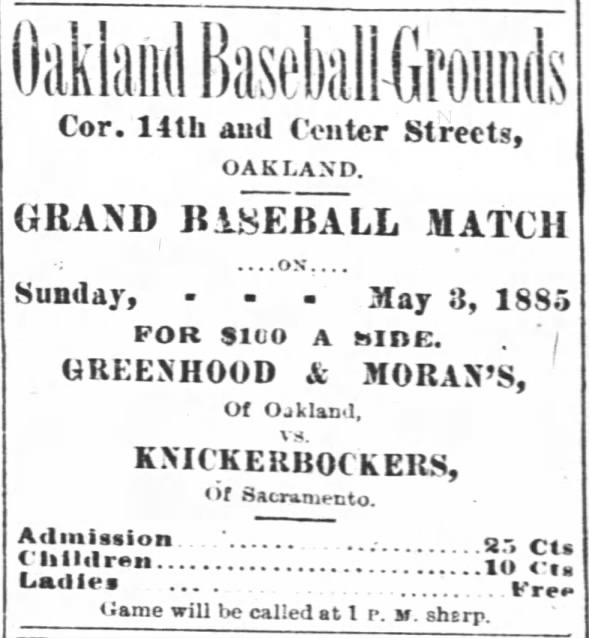 Oakland Baseball Grounds
14th & Center Streets · Fri, May 1, 1885 – Page 3 · Oakland Tribune (Oakland, California) · Newspapers.com
Oakland Baseball Grounds
14th & Center Streets · Fri, May 1, 1885 – Page 3 · Oakland Tribune (Oakland, California) · Newspapers.com

The Bicycling times and tourist's gazette
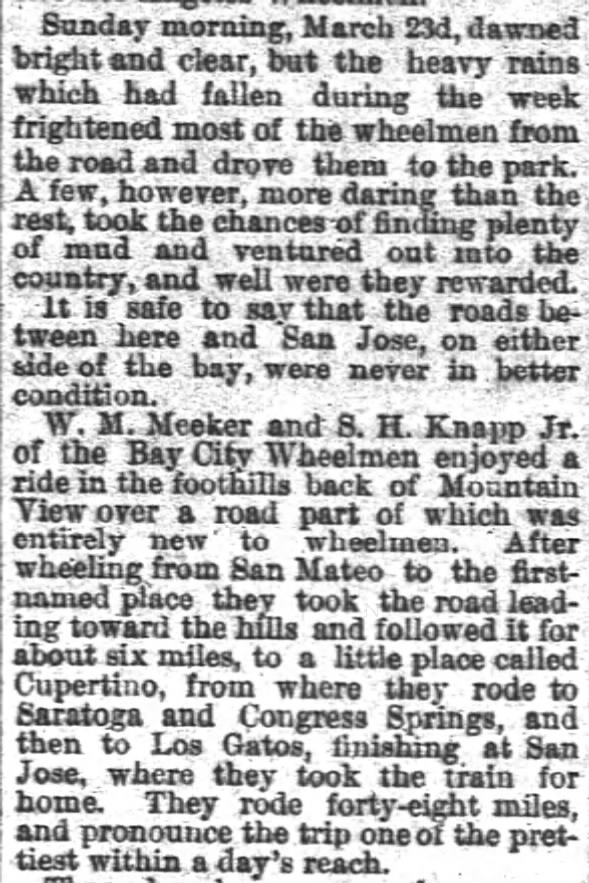 W. M. Meeker and S. H. Knapp Jr ride to a little place called Cupertino · Mon, Apr 1, 1889 – Page 5 · San Francisco Chronicle (San Francisco, California) · Newspapers.com
W. M. Meeker and S. H. Knapp Jr ride to a little place called Cupertino · Mon, Apr 1, 1889 – Page 5 · San Francisco Chronicle (San Francisco, California) · Newspapers.com
 W. M. Meeker & S. H. Knapp Jr. trip Spanishtown road to Wylie's on the summit · Mon, May 27, 1889 – Page 5 · San Francisco Chronicle (San Francisco, California) · Newspapers.com
W. M. Meeker & S. H. Knapp Jr. trip Spanishtown road to Wylie's on the summit · Mon, May 27, 1889 – Page 5 · San Francisco Chronicle (San Francisco, California) · Newspapers.com
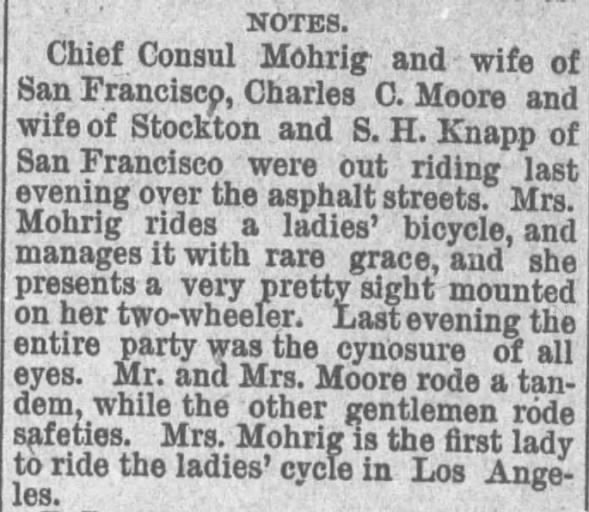 · Thu, May 30, 1889 – 2 · The Los Angeles Times (Los Angeles, California) · Newspapers.com
· Thu, May 30, 1889 – 2 · The Los Angeles Times (Los Angeles, California) · Newspapers.com
The run of the Bay City Wheelmen on July 28 was a most enjoyable one, but it was eclipsed on the 5th inst by the picnic run, that, for variety, could hardly be equaled anywhere. The members of the club and four of the Oak Leaf Wheelmen, of Stockton, who were their guests, left this city at 8:30, and riding leisurely down the Bay road reached San Mateo (twenty miles) at 11:30. The run was met a short distance from town by S. H. Knapp, Jr of the Commissary Department, and the usual refreshments in the shape of milk and crackers was dispensed. Wheels were again mounted, and the picnic grounds were soon reached. Here were found a number of the Garden City Wheelmen, of San Jose, who had ridden up thirty miles to attend the run. The lunch was soon attacked, and its disappearance was a matter of a very short time. The committee, with wise forethought, had provided an extra supply of everything, and this supply followed the course of the other edibles. After dinner the members and guests, numbering fifty-five, were photographed, the photographer finding great difficulty, as usual, in keeping his subjects still. After dinner the riders visited the great dam of the Spring Valley Water Works and viewed it with much interest. This dam has been in course of construction for five years, and has had at times nearly one thousand men working on it. Over 200,000 barrels of the best Portland cement were used in it, and it is to cost about $4,000,000.
Steve Knapp, as lecturer, was a huge success. After absorbing a great deal of information regarding dams, the boys started for the beach, and were soon swimming in the pleasantly warm waters of the Bay. On the road leading from the beach is the home of D. W. Donnelly, a member of the club. The riders were invited in and regaled with fruit and watermelons, freshly picked.
The riders started for home at 4 o'clock, and arrived in the city at 7 o'clock. The Stockton Club members were delighted with their outing, and invited the club to their city on the 11th to visit Lodi, the great watermelon district of ihe State. Dr. C. C. Moore, of Stockton, has promised to provide a sufficient quantity of his H. H. H. medicine, to cure any riders attacked by illness from eating too much melon.
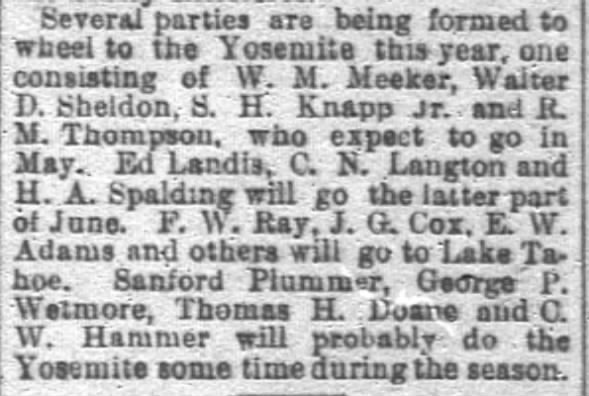 · Mon, Mar 31, 1890 – Page 5 · San Francisco Chronicle (San Francisco, California) · Newspapers.com
· Mon, Mar 31, 1890 – Page 5 · San Francisco Chronicle (San Francisco, California) · Newspapers.com
 · Mon, Jun 16, 1890 – Page 5 · San Francisco Chronicle (San Francisco, California) · Newspapers.com
· Mon, Jun 16, 1890 – Page 5 · San Francisco Chronicle (San Francisco, California) · Newspapers.com
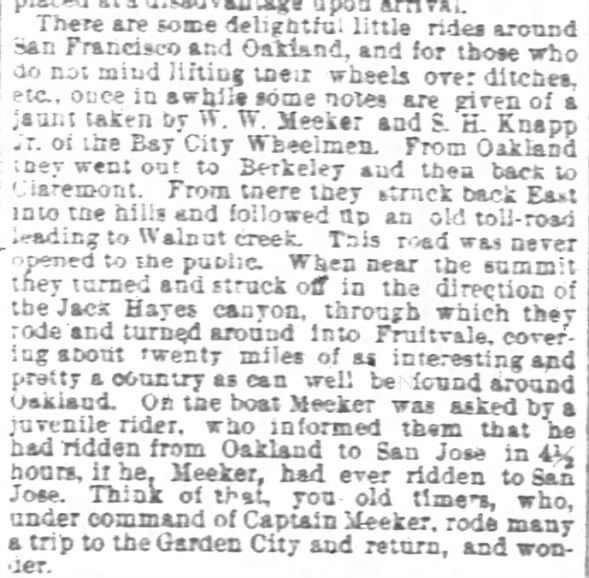 · Mon, May 25, 1891 – Page 8 · San Francisco Chronicle (San Francisco, California) · Newspapers.com
· Mon, May 25, 1891 – Page 8 · San Francisco Chronicle (San Francisco, California) · Newspapers.com
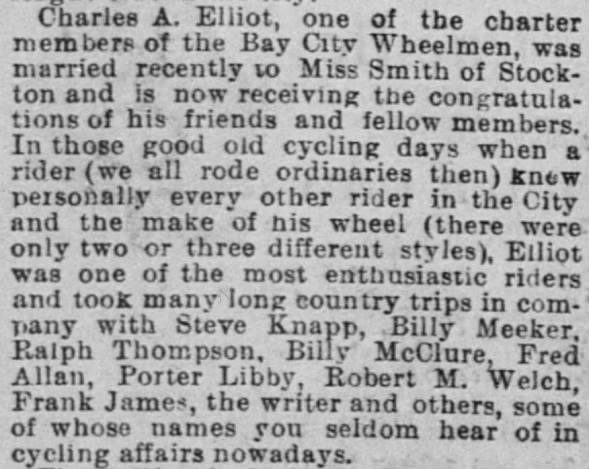 · Sat, Jul 4, 1896 – Page 10 · The San Francisco Call (San Francisco, California) · Newspapers.com
· Sat, Jul 4, 1896 – Page 10 · The San Francisco Call (San Francisco, California) · Newspapers.com
[W. M. Meeker was a founding member of the Bay City Wheelmen in 1884. - MF]
To the Summit of Mount Diablo by Wheel
...Wheel
(Official organ L. A. W.)
Edwin Mohrig, San Francisco, chief consul; J. Phil Percival, Los Angeles, vice-consul; Alexander S. Ireland, San Francisco, secretary-treasurer. Representatives - George H. Frost, Pasadena; Charles C. Moore, Stockton; Dr. Thomas L. Hill, Dr. L. N. Sandford, San Francisco. Dr. J. M. Curragh, San Francisco, representative San Francisco Bicycle Club; Representatives Bay City Wheelman - J. J. Bliss and Charles C. Moore, San Francisco. J. W. A. Off Los Angeles representative Los Angeles Wheelmen.
At a special meeting of the Bay City Wheelmen, held Thursday evening last, it was decided to hold a race meet at the Haight-street track on Arbor Day, April 30th. A committee is already hard at work and promise a day's sport excelling anything ever held on the coast.
The track will immediately be put in first-class condition, and it is expected that fast time will be made.
This will probably be the only chance that racing-men will have this season, outside of the league meet at Los Angeles, and, as many will not be able to go so far, they will undoubtedly embrace this opportunity. Valuable prizes, similar to those contested for on New Year's Day last, will be given.
This is just the time of year for a race meet. Most of the riders have already done considerable road work, which will prove an excellent foundation to begin training on.
A great many new riders will be brought out. The Garden City Wheelmen will probably send up Smith and Garmosette to represent them on the track. It is to be hoped that Davis and Wheaton will reappear.
The track was too heavy for Ireland on New Year's Day, but he will have an opportunity now to appear at better advantage.
Richardson will enter the five-mile race. Wheelmen have for some time been anxious to see what he can do.
Pierson and Langton begin training to-day and Hammer, Plummer, Cox, English, Searles and a number of others are expected to follow suit this week.
What's the matter with Clarence Howard for the mile novice?
Two University championships, open to members of the University wheelmen only, will be among the entries for the day.
The fourth Bay City club run of the season was held on Sunday, March 30th. Twenty members participated, riding down the bay road to Redwood City, where the run was dismissed by Captain Cook. Some of the riders went to San Mateo for a swim, others returned via the Mission road, and Messrs. Skelton, McClure and Shockley went on to San Jose.
On Sunday next the Bay City Wheelmen will have a picnic run to San Mateo beach.
Mrs. Edwin Mohrig has the honor of being the first lady bicyclist on the coast. With very little practice she has mastered the mount and dismount, and is now able to handle the machine very gracefully and quite skillfully. It is to be hoped that other ladies will follow her example and discard the heavy tricycle for the lighter and much more comfortable machine.
[Note, all the bicycles in this article are "ordinary" bicycles, what we now call "pennyfarthings." Mounting and dismounting these things was no mean feat, especially in full skirts, as Mrs. Edwin Mohrig likely was. You'll notice below that "safety" bicycles are especially called out. The switch to the safety as predominant bicycle design in California didn't come for another three years or so. Here is a sense of what bicycles looked like in 1889. The switch from the 'ordinary' to the 'safety' (what we now call a 'bicycle') was happening when this article was written. - MF]
[The photo above was taken during the 'Century Run' in the clipping below. The predominant bike used in the 100-mile ride from San Francisco to Hollister was the ordinary, at 81%. One of the riders was "Captain" W. M. Meeker. It's likely that Meeker and Knapp rode ordinaries up Mt. Diablo... - MF]
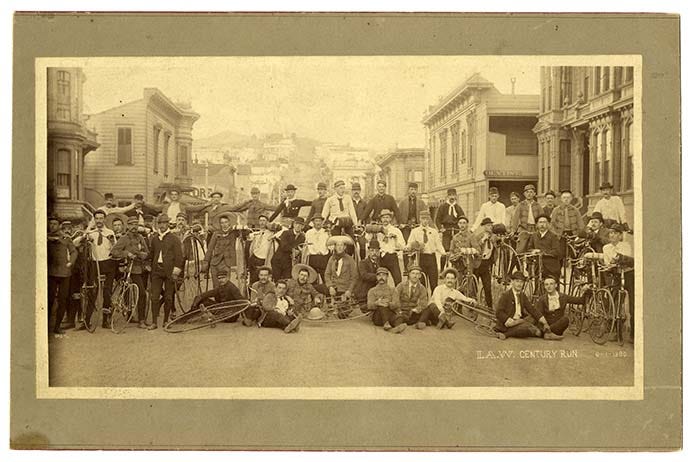 |
| Meeker is somewhere in this photo. 'League of American Wheelmen Century Run, June 1, 1890, in San Francisco at 21st and Capp Street. ( George R. Butler/California Historical Society)' |
At their last meeting the Bay City Wheelmen presented E. W. Adams with a very handsome gold medal set with diamonds in recognition of his ability as a trick rider and of services rendered the club as such.
The Bay Citys gave one of their old-time smokers at their clubrooms on Saturday evening. Music, recitations, cards, billiards, cigars, refreshments and a general Bay City good time were the order of the evening.
An article in a morning paper last week stated that a series of races would soon be run by Plummer and Wheaton. Neither of these gentlemen authorized any such statement and both are annoyed by the many notices which have lately appeared on the subject and which have had their origin in the fertile imagination of the writer, who evidently is not posted either as to the intentions of the two men or as to their abilities. He savs they are evenly matched, and certain distances would be very closely contested by them. This is anything but the case. For one mile or under Wheaton is fast, his record being 2:52, while Plummers is 3:07, and he would undoubtedly have the advantage of Plummer, but for any distance over one mile Plummer would have as great, if not a greater advantage over him. Both men realize this, and while it is possible that they may come together as contestants among others, they have no intentions of making up any match races.
The San Francisco Bicycle Club had seven members on their semi-monthly run last Sunday. This is not a very good showing for a club which claims a membership of seventy. By the way, how many of those seventy are members of the league? How does the San Francisco Bicycle Club hold its place in the league, if it has seventy members, when there are only about forty names from that club on the league roll? It would be in order for some member of that organization to rise and explain.
 · Wed, Apr 17, 1889 – Page 3 · Oakland Tribune (Oakland, California) · Newspapers.com
· Wed, Apr 17, 1889 – Page 3 · Oakland Tribune (Oakland, California) · Newspapers.com
What a blessing would be conferred upon suffering humanity if wheelmen in preparing accounts of their trips and experiences would dispense with the expression, "silent steel steed," and "merry cyclers."
There has for some time past been much speculation as to what adventures and interesting features a trip to Mount Diablo might possess. On Saturday, the 30th ult., two parties of wheelmen started out to investigate. The first, consisting of W. M. Meeker and S. H. Knapp Jr., left Oakland at 1:40 o'clock, and proceeding via the usual route to Walnut Creek, arrived there at 4:38 o'clock, finding the road thus far very good. Proceeding on their journey they found that the enterprising officials of the county or, perhaps the chain-gang, had been repairing the road to Alamo. The repairs so far consisted of its having been plowed for about six miles, all of which distance had to be walked. This, of course, took time, so they did not reach Cook's ranch, where they dined, till about 7 o'clock.
[I think Meeker and Knapp went up what we now call "South Gate Rd". From https://www.mdia.org/history-of-mount-diablo: "Colton's daughter Caroline and her husband, mining engineer Dan Cook, inherited the Railroad Ranch, which by then extended from Green Valley School to Sycamore Valley and to Curry Creek, taking in the headwaters of Marsh Creek, the southern summit road and the Mountain House Hotel. Brothers Dan and Seth Cook (both 'rough, obscenity-speaking and hearty fellows' according to R.N. Burgess) and changed the name to Cook Farms. Seth, a bachelor, inherited and passed the farm to his niece Louise and her husband John F. Boyd. Boyd renamed it the Oakwood Park Stock Farms and by 1897 it included 6,000 acres. By 1913 it grew to 15,000 acres, including areas of Dan Cook Canyon, Rock City, Devil's Slide and the area along South Gate Road, and was considered the largest stock farm in the world." See also this section of a book about Louise Boyd, and the history of the Diablo Country Club, which is at the base of "Dan Cook trail". - MF]
[I think Meeker and Knapp went up what we now call "South Gate Rd". From https://www.mdia.org/history-of-mount-diablo: "Colton's daughter Caroline and her husband, mining engineer Dan Cook, inherited the Railroad Ranch, which by then extended from Green Valley School to Sycamore Valley and to Curry Creek, taking in the headwaters of Marsh Creek, the southern summit road and the Mountain House Hotel. Brothers Dan and Seth Cook (both 'rough, obscenity-speaking and hearty fellows' according to R.N. Burgess) and changed the name to Cook Farms. Seth, a bachelor, inherited and passed the farm to his niece Louise and her husband John F. Boyd. Boyd renamed it the Oakwood Park Stock Farms and by 1897 it included 6,000 acres. By 1913 it grew to 15,000 acres, including areas of Dan Cook Canyon, Rock City, Devil's Slide and the area along South Gate Road, and was considered the largest stock farm in the world." See also this section of a book about Louise Boyd, and the history of the Diablo Country Club, which is at the base of "Dan Cook trail". - MF]
By this time it began to get dark, and they had yet four miles to travel, up the steep, rugged mountain, on which the road wound around and around over rocks, bowlders and all sorts of obstacles, in many places there being no road at all. A worse road could not be imagined, but it was so dark they couldn't see how bad it really was. Fortunately, one of them had a candle, brought along for cementing purposes in case of accident to a tire, and, whenever they lost the road, the candle was lit and held to the ground until a wagon track could be found.
Four long, weary miles of this sort of thing, every foot of which had to be walked, brought them at 10 o'clock to what is called the hotel, a neat little cottage, kept by M. Hunt, a very accommodating and entertaining host, who provided a most refreshing repast.
Asking to be called before daybreak they retired, but not to sleep very much. The wind began to blow, and such a blow they had never experienced before. They thought every moment the house would go tumbling down those steep precipices, of which they had a very distinct recollection, even though they had climbed them in the dark. At 4:30 o'clock A. M. they were called, and leaving their wheels at the hotel, they walked, again in the dark, to the summit of the mountain.
[See also this article from The San Francisco Call, 25 Aug 1890, Mon, Page 7, which states "Knapp and Hammer are the first who ever had their wheels crown the peak of Tamalpais..." However Joe Breeze points out; "Morgan, I believe Mill Valley Library has the East Peak register, or maybe it's the West Peak register. Anyway, I think the first bike entry within is from FEB1, 1885, by C. F. Merrinon (?) and W. E. Nachtrich of the Bay City Wheelmen. They most likely rode up the brand new Eldridge Grade, and were no doubt on highwheel bikes. I imagine there wasn't a lot of easy riding in either direction." - MF]
[See also this article from The San Francisco Call, 25 Aug 1890, Mon, Page 7, which states "Knapp and Hammer are the first who ever had their wheels crown the peak of Tamalpais..." However Joe Breeze points out; "Morgan, I believe Mill Valley Library has the East Peak register, or maybe it's the West Peak register. Anyway, I think the first bike entry within is from FEB1, 1885, by C. F. Merrinon (?) and W. E. Nachtrich of the Bay City Wheelmen. They most likely rode up the brand new Eldridge Grade, and were no doubt on highwheel bikes. I imagine there wasn't a lot of easy riding in either direction." - MF]
Words can hardly express what they saw. Being still dark, the first thing that they noticed were the lights in the following named cities; San Francisco, San Jose, Vallejo, Benicia, Stockton, Sacramento and Marysville, besides innumerable small towns in every direction.
Presently it began to get light, and as the faint rays began to peep up over the eastern horizon a most magnificent and really wonderful sight was spread before them. As the light grew stronger it cast a shadow of the mountain on a background of fog or mist which was hovering over the Golden Gate. The shadow grew stronger and stronger, till it looked as though another Diablo had risen up out of the ocean and rested upon the banks of the Golden Gate. When the sun itself finally burst into view the whole world seemed set on fire. The snow-capped Sierras could plainly be seen, and the peaks of Mount Hamilton, Loma Prieta and Tamalpais were very prominent. The view from Diablo must be seen to be appreciated.
Returning to the hotel for breakfast, they began the descent on the north side of the mountain.
After walking down two miles they found a road which in parts was rideable. When about a mile from the base of the mountain they met Sanford Plummer and R. M. Thompson, who had left Martinez at 6 o'clock that morning, and after having wheeled fifteen miles were just preparing to climb the mountain. Within three miles of the base of the mountain the road follows a creek and crosses it over fifty times. The creek can be ridden occasionally, but in most places there are too many rocks. After exchanging experiences the two parties continued on their respective journeys. The first named wheeled to Pinole, through Pacheco and Martinez, where they took the train home.
Plummer and Thompson climbed the mountain, pushing their wheels inverted before them. After a lunch at the hotel they climbed to the summit and spent nearly an hour there. Returning to the hotel, a good dinner awaited them, after partaking of which they began the descent over the road traveled the night before by Meeker and Knapp. In several places where the road wound around for half a mile or more and then returned about fifty yards below they lowered their wheels down the steep embankments and saved not a little time. Nevertheless it was the longest four miles down that mountain that they had ever covered.
The ever changing panorama, however, kept them interested, and finally reaching Cook's ranch, they found an excellent road to Danville and from there to Limerick, so they wheeled along and made up lost time. They went through Norris canyon, where they found seven miles of very rough road, after which a good road of five miles brought them to Haywards, where they took the train for home.
The distance from Martinez to the base of the mountain is sixteen miles, from the base to the top four miles, from the top to Cook's ranch six miles and from Cook's ranch to Haywards nineteen miles.
 Oakland Baseball Grounds
14th & Center Streets · Fri, May 1, 1885 – Page 3 · Oakland Tribune (Oakland, California) · Newspapers.com
Oakland Baseball Grounds
14th & Center Streets · Fri, May 1, 1885 – Page 3 · Oakland Tribune (Oakland, California) · Newspapers.com
The University Bicycle Club announces a bicycle field day at Fourteenth and Center streets, Oakland, for April 30th. Following is the programme: One-mile maiden (open); half mile, University Club championship (closed); three-mile handicap (open); one-mile special race; one hundred yards' handicap, foot-race (open); one-mile handicap (open); two-mile safety handicap (open); half-mile handicap run, foot-race (open); one-mile, University Club championship (closed); one-mile lap race (open).
The Bicycling times and tourist's gazette
Gold medals will be given for first place and silver for second place in any race in which there are more than two starters.
Entries for the University bicycle meet may be made at the office of Strong & Adams, 212 Market street, San Francisco; and Mr. Morhig, Golden Gate, San Francisco; with the secretary of the University Bicycle Club, or with Mr. Scott of the Olympic Club.
--------------------
The Further Adventures of Meeker and Knapp
 W. M. Meeker and S. H. Knapp Jr ride to a little place called Cupertino · Mon, Apr 1, 1889 – Page 5 · San Francisco Chronicle (San Francisco, California) · Newspapers.com
W. M. Meeker and S. H. Knapp Jr ride to a little place called Cupertino · Mon, Apr 1, 1889 – Page 5 · San Francisco Chronicle (San Francisco, California) · Newspapers.com W. M. Meeker & S. H. Knapp Jr. trip Spanishtown road to Wylie's on the summit · Mon, May 27, 1889 – Page 5 · San Francisco Chronicle (San Francisco, California) · Newspapers.com
W. M. Meeker & S. H. Knapp Jr. trip Spanishtown road to Wylie's on the summit · Mon, May 27, 1889 – Page 5 · San Francisco Chronicle (San Francisco, California) · Newspapers.com · Thu, May 30, 1889 – 2 · The Los Angeles Times (Los Angeles, California) · Newspapers.com
· Thu, May 30, 1889 – 2 · The Los Angeles Times (Los Angeles, California) · Newspapers.com
The run of the Bay City Wheelmen on July 28 was a most enjoyable one, but it was eclipsed on the 5th inst by the picnic run, that, for variety, could hardly be equaled anywhere. The members of the club and four of the Oak Leaf Wheelmen, of Stockton, who were their guests, left this city at 8:30, and riding leisurely down the Bay road reached San Mateo (twenty miles) at 11:30. The run was met a short distance from town by S. H. Knapp, Jr of the Commissary Department, and the usual refreshments in the shape of milk and crackers was dispensed. Wheels were again mounted, and the picnic grounds were soon reached. Here were found a number of the Garden City Wheelmen, of San Jose, who had ridden up thirty miles to attend the run. The lunch was soon attacked, and its disappearance was a matter of a very short time. The committee, with wise forethought, had provided an extra supply of everything, and this supply followed the course of the other edibles. After dinner the members and guests, numbering fifty-five, were photographed, the photographer finding great difficulty, as usual, in keeping his subjects still. After dinner the riders visited the great dam of the Spring Valley Water Works and viewed it with much interest. This dam has been in course of construction for five years, and has had at times nearly one thousand men working on it. Over 200,000 barrels of the best Portland cement were used in it, and it is to cost about $4,000,000.
Steve Knapp, as lecturer, was a huge success. After absorbing a great deal of information regarding dams, the boys started for the beach, and were soon swimming in the pleasantly warm waters of the Bay. On the road leading from the beach is the home of D. W. Donnelly, a member of the club. The riders were invited in and regaled with fruit and watermelons, freshly picked.
The riders started for home at 4 o'clock, and arrived in the city at 7 o'clock. The Stockton Club members were delighted with their outing, and invited the club to their city on the 11th to visit Lodi, the great watermelon district of ihe State. Dr. C. C. Moore, of Stockton, has promised to provide a sufficient quantity of his H. H. H. medicine, to cure any riders attacked by illness from eating too much melon.
 · Mon, Mar 31, 1890 – Page 5 · San Francisco Chronicle (San Francisco, California) · Newspapers.com
· Mon, Mar 31, 1890 – Page 5 · San Francisco Chronicle (San Francisco, California) · Newspapers.com
 · Mon, Jun 16, 1890 – Page 5 · San Francisco Chronicle (San Francisco, California) · Newspapers.com
· Mon, Jun 16, 1890 – Page 5 · San Francisco Chronicle (San Francisco, California) · Newspapers.com · Mon, May 25, 1891 – Page 8 · San Francisco Chronicle (San Francisco, California) · Newspapers.com
· Mon, May 25, 1891 – Page 8 · San Francisco Chronicle (San Francisco, California) · Newspapers.com · Sat, Jul 4, 1896 – Page 10 · The San Francisco Call (San Francisco, California) · Newspapers.com
· Sat, Jul 4, 1896 – Page 10 · The San Francisco Call (San Francisco, California) · Newspapers.com[W. M. Meeker was a founding member of the Bay City Wheelmen in 1884. - MF]

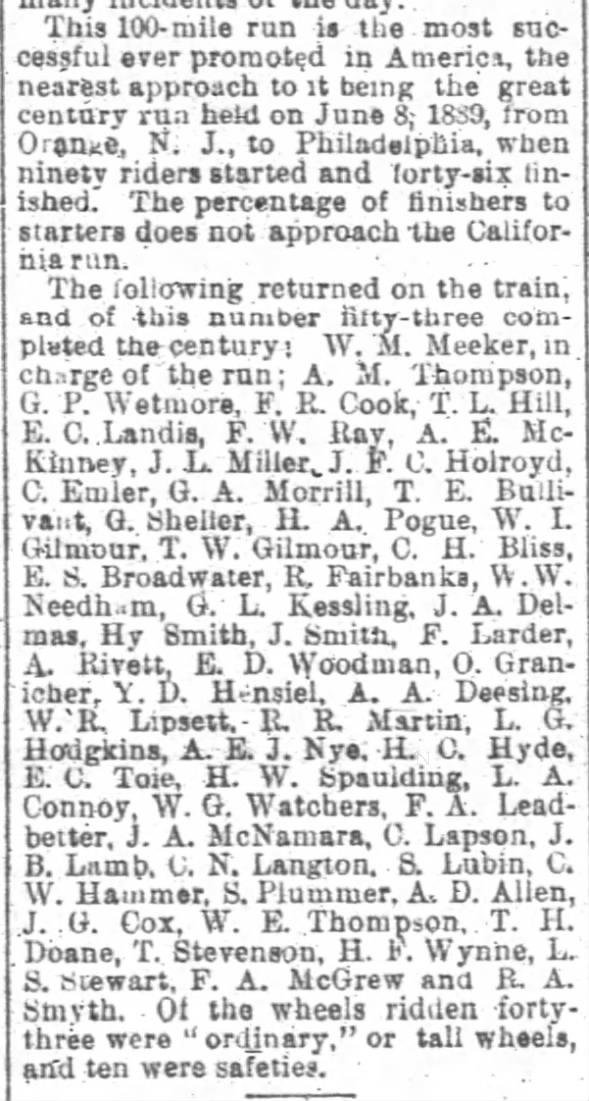
Comments
Post a Comment